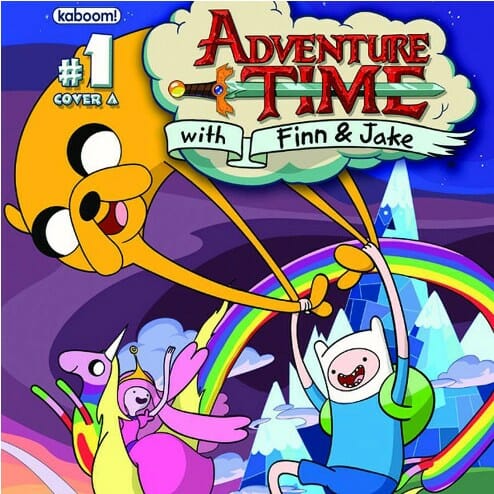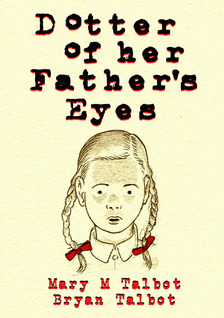
Each week, Paste reviews the most intriguing comic books, graphic novels, graphic memoirs and other illustrated books.

Adventure Time with Finn & Jake#1
by Ryan North, Shelli Paroline and Aaron Renier
kaboom!, 2012
Rating: 7.8
Cartoon Network’s Adventure Time is a cult hit among imaginative kids, bored parents and artsy hipsters alike. Creator Pendleton Ward crafts a cheerful post-apocalyptic playground where Finn (a human boy) and Jake (his magical dog) find old VHS tapes and flirt with bubble gum princesses during their quirky adventures. The humor winks bluntly at adults without isolating their progeny, striking a sublime balance of wry non-sequiturs and goofy slapstick. After the show cast former 70’s Hulk Lou Ferrigno as an elderly adventurer, the prospect of a comic book incarnation didn’t seem too far off. With the help of Boom! and online funnyman Ryan North (Dinosaur Comics), Finn and Jake make the seamless transition to sequential art. The closest comparison to Adventure Time would be the work of James Kolchaka, whose vibrant visuals, stringy anatomy and charming wit make books like Dragon Puncher seem more like distant cousins than separate properties. Which isn’t to say that Adventure Time doesn’t have its own eccentric identity. This first issue shows the titular pair parade their fantastic world through a homemade dance video and mock an animated skeleton for having gross hands that “nobody ever wants to hold.” The bonus story about an anthropomorphic cinnamon bun (SPOILER ALERT) who brews apple cider with its sweat is even better. The book feels like it ends as soon as you open it, but with such a dazzling array of colors and characters, it’s difficult to complain. (SE)
Dotter of Her Father’s Eyes
by Mary M. Talbot and Bryan Talbot
Dark Horse, 2012
Rating: 6.0
Both a personal memoir and a recounting of the early life of James Joyce’s daughter Lucia, who is mostly known for having spent a large portion of years in mental institutions, Dotter of Her Father’s Eyes is Mary Talbot’s first effort in the field of graphic novels. Her husband, Bryan Talbot, has worked as an artist in the medium for much longer. Those two facts are fairly illuminating. The book is interesting, but Mary’s lack of experience in constructing a non-academic narrative (she has another career as a feminist scholar) shows to some extent, while Bryan’s pages are more assured. The idea is that Mary’s early life, as daughter of an eminent Joycean scholar, has some parallels with Lucia’s, but the story doesn’t really bear them out, interesting as it is. If anything, the similarities between them result from their both being women and, therefore, second-class citizens rather than from any connection to Joyce. The book could have used a stronger hand to bring out its points and its audience is unclear, but its picture of 1950s to 1970s England is nicely done and it captures the fear all children have of displeasing their parents. (HB)

Rust, vol. 1: Visitor in the Field
by Royden Lepp
Archaia Entertainment, 2012
Rating: 6.5
It is absolutely no surprise to learn that Royden Lepp’s steampunkish book has already been optioned for a movie. The pacing throughout is spot-on, and the story (robots, post-war, mysterious boy with a jetpack) easily compelling and adaptable. Its weaknesses, too, can be covered up or eliminated in a new format: annoying lettering, occasionally obvious panel composition, a color palette that’s a bit too committed to brown, ugly blurs that seem computer-assisted. Lepp has a real talent for drawing action scenes, though, and I imagine some of the big set-piece battles between man and machine will be complex to recreate filmically. You always know exactly what’s going on and who’s where, something that is exceedingly rare to find. Are the plot twists a bit predictable? The characters not fleshed out enough? Yes and yes, but there’s some charm here, and both of those flaws are somewhat expected with material of this kind. Preadolescent boys will overlook them, and there are many worse things they could be reading. (HB)
Mixtape #1
by Brad Abraham, Gervasio and Jok
Ardden Comics, 2012
Rating: 5.5
I can get extremely annoyed when a book or movie fetishizes music. That’s because I basically fetishize it myself. It’s uncomfortable to recognize myself in High Fidelity’s clueless, self-obsessed, self-appointed guardians of middle-brow taste. Phonogram, an enjoyable music-minded comic from Kieron Gillen and Jamie McKelvie, largely avoids this problem by focusing on the active enjoyment of music in bars and clubs. Its characters don’t just sit around and talk about their record collection. Mixtape aspires to be an American Phonogram, but swaps out the magic and modern-day setting with the tone of a John Hughes teen movie. Its many musical references aren’t to British “indie” bands but to the more rigidly defined American indie-rock of the 80s and 90s, bands like Sonic Youth and the Pixies. These references aren’t particularly clever or insightful, and although the “this is our music! this is our time!” attitude fits a teenager, especially a seventeen year old indie rocker stuck in pre-Nirvana 1990, there’s no subtlety here. I’m sure many high school girls rhapsodized about seeing the Pixies in concert, but Mixtape makes the mistake of talking about how important everything is without ever trying to explain why. There’s potential for effective Hughesian drama with the central romantic triangle, and if writer Brad Abraham can develop a more naturalistic voice for his characters Mixtape could be a solid series. And at lease these are teenagers obsessing over music and not a middle-aged John Cusack. (GM)

